The content of this website is no longer being updated. For information on current assessment activities, please visit http://www.globalchange.gov/what-we-do/assessment
Islands
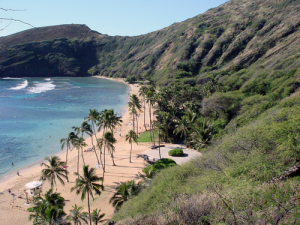 Climate change presents the Pacific and Caribbean islands with unique challenges. The U.S. affiliated Pacific Islands are home to approximately 1.7 million people in the Hawaiian Islands; Palau; the Samoan Islands of Tutuila, Manua, Rose, and Swains; and islands in the Micronesian archipelago, the Carolines, Marshalls, and Marianas.1 These include volcanic, continental, and limestone islands, atolls, and islands of mixed geologies.1 The degree to which climate change and variability will affect each of the roughly 30,000 islands in the Pacific depends upon a variety of factors, including the island’s geology, area, height above sea level, extent of reef formation, and the size of its freshwater aquifer.2
Climate change presents the Pacific and Caribbean islands with unique challenges. The U.S. affiliated Pacific Islands are home to approximately 1.7 million people in the Hawaiian Islands; Palau; the Samoan Islands of Tutuila, Manua, Rose, and Swains; and islands in the Micronesian archipelago, the Carolines, Marshalls, and Marianas.1 These include volcanic, continental, and limestone islands, atolls, and islands of mixed geologies.1 The degree to which climate change and variability will affect each of the roughly 30,000 islands in the Pacific depends upon a variety of factors, including the island’s geology, area, height above sea level, extent of reef formation, and the size of its freshwater aquifer.2
In addition to Puerto Rico and the U.S. Virgin Islands, there are 40 island nations in the Caribbean that are home to approximately 38 million people.3 Population growth, often concentrated in coastal areas, escalates the vulnerability of both Pacific and Caribbean island communities to the effects of climate change, as do weakened traditional support systems. Tourism and fisheries, both of which are climate-sensitive, play a large economic role in these communities.1
Small islands are considered among the most vulnerable to climate change because extreme events have major impacts on them. Changes in weather patterns and the frequency and intensity of extreme events, sea-level rise, coastal erosion, coral reef bleaching, ocean acidification, and contamination of freshwater resources by salt water are among the impacts small islands face.4
Islands have experienced rising temperatures and sea levels in recent decades. Projections for the rest of this century suggest:
- Increases in air and ocean surface temperatures in both the Pacific and Caribbean;5
- An overall decrease in rainfall in the Caribbean; and
- An increased frequency of heavy downpours and increased rainfall during summer months (rather than the normal rainy season in winter months) for the Pacific (although the range of projections regarding rainfall in the Pacific is still quite large).
Air Temperature Change, Observed and Projected, 1900 to 2100 relative to 1960-1979 average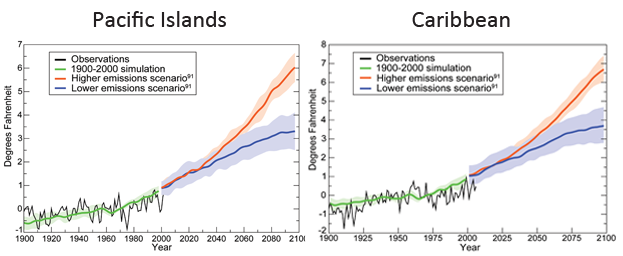 Air temperatures have increased over the last 100 years in both the Pacific Island and Caribbean regions. Larger increases are projected in the future, with higher emissions scenarios6 producing considerably greater increases. The shaded areas show the likely ranges while the lines show the central projections from a set of climate models. Image References: Smith et al.7, CMIP3-A8
Air temperatures have increased over the last 100 years in both the Pacific Island and Caribbean regions. Larger increases are projected in the future, with higher emissions scenarios6 producing considerably greater increases. The shaded areas show the likely ranges while the lines show the central projections from a set of climate models. Image References: Smith et al.7, CMIP3-A8
The number of heavy rain events is very likely to increase.5 Hurricane (typhoon) wind speeds and rainfall rates are likely to increase with continued warming.9 Islands and other low-lying coastal areas will be at increased risk from coastal inundation due to sea-level rise and storm surge, with major implications for coastal communities, infrastructure, natural habitats, and resources.
Freshwater Resources
The availability of freshwater is likely to be reduced, with significant implications for island communities, economies, and resources.
Freshwater Lens Many island communities depend on freshwater lenses, which are recharged by precipitation. The amount of water a freshwater lens contains is determined by the size of the island, the amount of rainfall, rates of water withdrawal, the permeability of the rock beneath the island, and salt mixing due to storm- or tide-induced pressure. Freshwater lenses can be as shallow as 4 to 8 inches or as deep as 65 feet.10 Image Source: adapted from Burns10Most island communities in the Pacific and the Caribbean have limited sources of the freshwater needed to support unique ecosystems and biodiversity, public health, agriculture, and tourism. Conventional freshwater resources include rainwater collection, groundwater, and surface water.10 For drinking and bathing, smaller Pacific islands primarily rely on individual rainwater catchment systems, while groundwater from the freshwater lens is used for irrigation. The size of freshwater lenses in atolls is influenced by factors such as rates of recharge (through precipitation), rates of use, and extent of tidal inundation.2 Since rainfall triggers the formation of the freshwater lens, changes in precipitation, such as the significant decreases projected for the Caribbean, can significantly affect the availability of water. Because tropical storms replenish water supplies, potential changes in these storms are a great concern.
Many island communities depend on freshwater lenses, which are recharged by precipitation. The amount of water a freshwater lens contains is determined by the size of the island, the amount of rainfall, rates of water withdrawal, the permeability of the rock beneath the island, and salt mixing due to storm- or tide-induced pressure. Freshwater lenses can be as shallow as 4 to 8 inches or as deep as 65 feet.10 Image Source: adapted from Burns10Most island communities in the Pacific and the Caribbean have limited sources of the freshwater needed to support unique ecosystems and biodiversity, public health, agriculture, and tourism. Conventional freshwater resources include rainwater collection, groundwater, and surface water.10 For drinking and bathing, smaller Pacific islands primarily rely on individual rainwater catchment systems, while groundwater from the freshwater lens is used for irrigation. The size of freshwater lenses in atolls is influenced by factors such as rates of recharge (through precipitation), rates of use, and extent of tidal inundation.2 Since rainfall triggers the formation of the freshwater lens, changes in precipitation, such as the significant decreases projected for the Caribbean, can significantly affect the availability of water. Because tropical storms replenish water supplies, potential changes in these storms are a great concern.
Caribbean Precipitation Change 1900 to 2100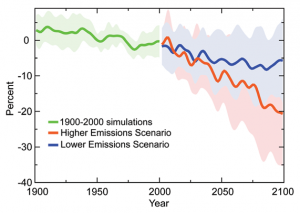 Total annual precipitation has declined in the Caribbean and climate models project stronger declines in the future, particularly under higher emission scenarios.6 Such decreases threaten island communities that rely on rainfall for replenishing their freshwater supplies. The shaded areas show the likely ranges while the lines show the central projections from a set of climate models. Image Reference: CMIP3-A8
Total annual precipitation has declined in the Caribbean and climate models project stronger declines in the future, particularly under higher emission scenarios.6 Such decreases threaten island communities that rely on rainfall for replenishing their freshwater supplies. The shaded areas show the likely ranges while the lines show the central projections from a set of climate models. Image Reference: CMIP3-A8
While it might initially be seen as a benefit, increased rainfall in the Pacific Islands during the summer months is likely to result in increased flooding, which would reduce drinking water quality and crop yields.10 In addition, many islands have weak distribution systems and old infrastructure, which result in significant water leakage, decreasing their ability to use freshwater efficiently. Water pollution (such as from agriculture or sewage), exacerbated by storms and floods, can contaminate the freshwater supply, affecting public health. Sea-level rise also affects island water supplies by causing salt water to contaminate the freshwater lens and by causing an increased frequency of flooding due to storm high tides.2 Finally, a rapidly rising population is straining the limited water resources, as would an increased incidence and/or intensity of storms10 or periods of prolonged drought.
Adaptation: Securing Water Resources
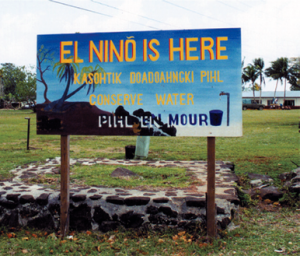 A billboard on Pohnpei, in the Federated States of Micronesia, encourages water conservation in preparation for the 1997 to 1998 El Niño.In the islands, “water is gold.” Effective adaptation to climate-related changes in the availability of freshwater is thus a high priority. While island communities cannot completely counter the threats to water supplies posed by global warming, effective adaptation approaches can help reduce the damage.
A billboard on Pohnpei, in the Federated States of Micronesia, encourages water conservation in preparation for the 1997 to 1998 El Niño.In the islands, “water is gold.” Effective adaptation to climate-related changes in the availability of freshwater is thus a high priority. While island communities cannot completely counter the threats to water supplies posed by global warming, effective adaptation approaches can help reduce the damage.
When existing resources fall short, managers look to unconventional resources, such as desalinating seawater, importing water by ship, and using treated wastewater for non-drinking uses. Desalination costs are declining, though concerns remain about the impact on marine life, the disposal of concentrated brines that may contain chemical waste, and the large energy use (and associated carbon footprint) of the process.11 With limited natural resources, the key to successful water resource management in the islands will continue to be “conserve, recover, and reuse.”1
Pacific Island communities are also making use of the latest science. This effort started during the 1997 to 1998 El Niño, when managers began using seasonal forecasts to prepare for droughts by increasing public awareness and encouraging water conservation. In addition, resource managers can improve infrastructure, such as by fixing water distribution systems to minimize leakage and by increasing freshwater storage capacity.1
Sea-level Rise and Coastal Storms
Island communities, infrastructure, and ecosystems are vulnerable to coastal inundation due to sea-level rise and coastal storms.
Sea-level rise will have enormous effects on many island nations. Flooding will become more frequent due to higher storm tides, and coastal land will be permanently lost as the sea inundates low-lying areas and the shorelines erode. Loss of land will reduce freshwater supplies2 and affect living things in coastal ecosystems. For example, the Northwestern Hawaiian Islands, which are low-lying and therefore at great risk from increasing sea level, have a high concentration of endangered and threatened species, some of which exist nowhere else.12 The loss of nesting and nursing habitat is expected to threaten the survival of already vulnerable species.12
Extreme Sea-Level Days: Honolulu, Hawaii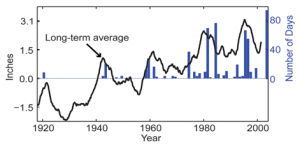 Sea-level rise will result in permanent land loss and reductions in freshwater supplies, as well as threaten coastal ecosystems. “Extreme” sea-level days (with a daily average of more than 6 inches above the long-term average5) can result from the combined effects of gradual sea-level rise due to warming and other phenomena, including seasonal heating and high tides. Image Reference: Firing and Merrifield13In addition to gradual sea-level rise, extreme high water level events can result from a combination of coastal processes.14 For example, the harbor in Honolulu, Hawaii, experienced the highest daily average sea level ever recorded in September 2003. This resulted from the combination of long-term sea-level rise, normal seasonal heating (which causes the volume of water to expand and thus the level of the sea to rise), seasonal high tide, and an ocean circulation event which temporarily raised local sea level.13 The interval between such extreme events has decreased from more than 20 years to approximately 5 years as average sea level has risen.13
Sea-level rise will result in permanent land loss and reductions in freshwater supplies, as well as threaten coastal ecosystems. “Extreme” sea-level days (with a daily average of more than 6 inches above the long-term average5) can result from the combined effects of gradual sea-level rise due to warming and other phenomena, including seasonal heating and high tides. Image Reference: Firing and Merrifield13In addition to gradual sea-level rise, extreme high water level events can result from a combination of coastal processes.14 For example, the harbor in Honolulu, Hawaii, experienced the highest daily average sea level ever recorded in September 2003. This resulted from the combination of long-term sea-level rise, normal seasonal heating (which causes the volume of water to expand and thus the level of the sea to rise), seasonal high tide, and an ocean circulation event which temporarily raised local sea level.13 The interval between such extreme events has decreased from more than 20 years to approximately 5 years as average sea level has risen.13
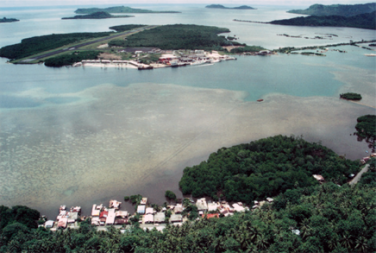 Coastal houses and an airport in the U.S.- affiliated Federated States of Micronesia rely on mangroves’ protection from erosion and damage due to rising sea level, waves, storm surges, and wind.Hurricanes, typhoons, and other storm events, with their intense precipitation and storm surge, cause major impacts to Pacific and Caribbean island communities, including loss of life, damage to infrastructure and property, and contamination of freshwater supplies.15 As the climate continues to warm, the peak wind intensities and near-storm precipitation from future tropical cyclones are likely to increase,5 which, combined with sea-level rise, is expected to cause higher storm surge levels. If such events occur frequently, communities would face challenges in recovering between events, resulting in long-term deterioration of infrastructure, freshwater and agricultural resources, and other impacts.16
Coastal houses and an airport in the U.S.- affiliated Federated States of Micronesia rely on mangroves’ protection from erosion and damage due to rising sea level, waves, storm surges, and wind.Hurricanes, typhoons, and other storm events, with their intense precipitation and storm surge, cause major impacts to Pacific and Caribbean island communities, including loss of life, damage to infrastructure and property, and contamination of freshwater supplies.15 As the climate continues to warm, the peak wind intensities and near-storm precipitation from future tropical cyclones are likely to increase,5 which, combined with sea-level rise, is expected to cause higher storm surge levels. If such events occur frequently, communities would face challenges in recovering between events, resulting in long-term deterioration of infrastructure, freshwater and agricultural resources, and other impacts.16
Critical infrastructure, including homes, airports, and roads, tends to be located along the coast. Flooding related to sea-level rise and hurricanes and typhoons negatively affects port facilities and harbors, and causes closures of roads, airports, and bridges.17 Long-term infrastructure damage would affect social services such as disaster risk management, health care, education, management of freshwater resources, and economic activity in sectors such as tourism and agriculture.
Marine and Coastal Ecosystems
Climate changes affecting coastal and marine ecosystems will have major implications for tourism and fisheries.
Marine and coastal ecosystems of the islands are particularly vulnerable to the impacts of climate change. Sea-level rise, increasing water temperatures, rising storm intensity, coastal inundation and flooding from extreme events, beach erosion, ocean acidification, increased incidences of coral disease, and increased invasions by non-native species are among the threats that endanger the ecosystems that provide safety, sustenance, economic viability, and cultural and traditional values to island communities.18
Tourism is a vital part of the economy for many islands. In 1999, the Caribbean had tourism-based gross earnings of $17 billion, providing 900,000 jobs and making the Caribbean one of the most tourism dependent regions in the world.3 In the South Pacific, tourism can contribute as much as 47 percent of gross domestic product.19 In Hawaii, tourism generated $12.4 billion for the state in 2006, with over 7 million visitors.20
Sea-level rise can erode beaches, and along with increasing water temperatures, can destroy or degrade natural resources such as mangroves and coral reef ecosystems that attract tourists.16 Extreme weather events can affect transportation systems and interrupt communications. The availability of freshwater is critical to sustaining tourism, but is subject to the climate-related impacts described in the previous section. Public health concerns about diseases would also negatively affect tourism.
Coral reefs sustain fisheries and tourism, have biodiversity value, scientific and educational value, and form natural protection against wave erosion.21 For Hawaii alone, net benefits of reefs to the economy are estimated at $360 million annually, and the overall asset value is conservatively estimated to be nearly $10 billion.21 In the Caribbean, coral reefs provide annual net benefits from fisheries, tourism, and shoreline protection services of between $3.1 billion and $4.6 billion. The loss of income by 2015 from degraded reefs is conservatively estimated at several hundred million dollars annually.3,22
Coral reef ecosystems are particularly susceptible to the impacts of climate change, as even small increases in water temperature can cause coral bleaching,23 damaging and killing corals. Ocean acidification due to a rising carbon dioxide concentration poses an additional threat (see Ecosystems sector and Coasts region). Coral reef ecosystems are also especially vulnerable to invasive species.24 These impacts, combined with changes in the occurrence and intensity of El Niño events, rising sea level, and increasing storm damage,16 will have major negative effects on coral reef ecosystems.
Fisheries feed local people and island economies. Almost all communities within the Pacific Islands derive over 25 percent of their animal protein from fish, with some deriving up to 69 percent.25 For island fisheries sustained by healthy coral reef and marine ecosystems, climate change impacts exacerbate stresses such as overfishing,16 affecting both fisheries and tourism that depend on abundant and diverse reef fish. The loss of live corals results in local extinctions and a reduced number of reef fish species.26
Nearly 70 percent of the world’s annual tuna harvest, approximately 3.2 million tons, comes from the Pacific Ocean.27 Climate change is projected to cause a decline in tuna stocks and an eastward shift in their location, affecting the catch of certain countries.16
References
- 1. a. b. c. d. e. [530] Shea, E. L., G. Dolcemascolo, C. L. Anderson, A. Barnston, C. P. Guard, M. P. Hamnett, S. T. Kubota, N. Lewis, J. Loschnigg, and G. A. Meehl. Preparing for a Changing Climate: The Potential Consequences of Climate Variability and Change: Pacific Islands. Honolulu, HI: East-West Center, 2001.
- 2. a. b. c. d. [531] Guidry, M. W., and F. T. Mackenzie. Climate Change, Water Resources, and Sustainability in the Pacific Basin: Emphasis on O'ahu, Hawai'l and Majuro Atoll, Republic of the Marshall Islands. Honolulu, HI: University of Hawaii Sea Grant Program, 2006.
- 3. a. b. c. [532] CEO. Caribbean Environmental Outlook, Edited by S. Heileman, L. J. Walling, C. Douglas, M. Mason and M. Chevannes-Creary. Kingston, Jamaica: United Nations Environmental Programme, 2004.
- 4. [533] Church, J. A., N. J. White, and J. R. Hunter. "Sea-level Rise at Tropical Pacific and Indian Ocean Islands." Global and Planetary Change 53, no. 3 (2006): 155-168.
- 5. a. b. c. d. [90] Meehl, G. A., T. F. Stocker, W. D. Collins, P. Friedlingstein, A. T. Gaye, JM Gregory, A. Kitoh, R. Knutti, J. M. Murphy, A. Noda et al. "Global Climate Projections." In Climate Change 2007: The Physical Basis, edited by S. Solomon, D. Qin, M. Manning, Z. Chen, M. Marquis, K. B. Averyt, M. Tignor and H. L. Miller, 747-845. Vol. Contribution of Working Group I to the Fourth Assessment Report of the Intergovernmental Panel on Climate Change. Cambridge, UK and New York, NY: Cambridge University Press, 2007.
- 6. a. b. [91] various. footnote 91., 2009.
- 7. [72] Smith, T. M., R. W. Reynolds, T. C. Peterson, and J. Lawrimore. "Improvements to NOAA's Historical Merged Land-Ocean Surface Temperature Analysis (1880-2006)." Journal of Climate 21, no. 10 (2008): 2283-2296.
- 8. a. b. [93] various. footnote 93., 2009.
- 9. [68] Gutowski, W. J., G. C. Hegerl, G. J. Holland, T. R. Knutson, L. Mearns, R. J. Stouffer, P. J. Webster, M. F. Wehner, and F. W. Zwiers. "Causes of Observed Changes in Extremes and Projections of Future Changes." In Weather and Climate Extremes in a Changing Climate: Regions of Focus: North America, Hawaii, Caribbean, and U.S. Pacific Islands, edited by T. R. Karl, G. A. Meehl, C. D. Miller, S. J. Hassol, A. M. Waple and W. L. Murray, 81-116. Vol. Synthesis and Assessment Product 3.3. Washington, D.C.: U.S. Climate Change Science Program, 2008.
- 10. a. b. c. d. e. [534] Burns, W. C. G.. "Pacific Island Developing Country Water Resources and Climate Change." In The World's Water, edited by P. H. Gleick, 113-132. Third Edition. Washington, D.C.: Island Press, 2002.
- 11. [146] Kundzewicz, Z. W., L. J. Mata, N. W. Arnell, P. Doll, P. Dabat, B. Jimenez, K. A. Miller, T. Oki, Z. Sen, and I. A. Shiklomanov. "Freshwater Resources and Their Management." In Climate Change 2007: Impacts, Adaptation and Vulnerability, edited by M. L. Parry, O. F. Canziani, J. P. Palutikof, P. J. van der Linden and C. E. Hanson, 173-210. Vol. Contribution of Working Group II to the Fourth Assessment Report of the Intergovernmental Panel on Climate Change. Cambridge, UK and New York, NY: Cambridge University Press, 2007.
- 12. a. b. [535] Baker, J. D., C. L. Littnan, and D. W. Johnston. "Potential Effects of Sea Level Rise on the Terrestrial Habitats of Endangered and Endemic Megafauna in the Northwestern Hawaiian Islands." Endangered Species Research 2 (2006): 21-30.
- 13. a. b. c. [536] Firing, Y. L., and M. A. Merrifield. "Extreme Sea Level Events at Hawaii: Influence of Mesoscale Eddies." Geophysical Research Letters 31 (2004).
- 14. [271] Titus, J. G., J. E. Neumann, K. E. Anderson, D. R. Cahoon, D. B. Gesch, S. K. Gill, B. T. Gutierrez, E. R. Thieler, and S. J. Williams. "Implications for Decisions." In Coastal Elevations and Sensitivity to Sea-level Rise: A Focus on the Mid-Atlantic Region, 141-156. Vol. Synthesis and Assessment Product 4.1. Washington, D.C.: U.S. Environmental Protection Agency, 2009.
- 15. [537] Scott, D., M. Overmars, T. Falkland, and C. Carpenter. Pacific Dialogue on Water and Climate, Synthesis Reprt. Fiji Islands: South Pacific Applied Geoscience Commission, 2003.
- 16. a. b. c. d. e. [246] Mimura, N., L. Nurse, R. F. McLean, J. Agard, L. Briguglio, P. Lefale, R. Payet, and G. Sem. "Small Islands." In Climate Change 2007: Impacts, Adaptation and Vulnerability, edited by M. L. Parry, O. F. Canziani, J. P. Palutikof, P. J. van der Linden and C. E. Hanson, 687-716. Vol. Contribution of Working Group II to the Fourth Assessment Report of the Intergovernmental Panel on Climate Change. Cambridge, UK and New York, NY: Cambridge University Press, 2007.
- 17. [538] Hay, J. E., N. Mimura, J. Campbell, S. Fifita, K. Koshy, R. F. McLean, T. Nakalevu, P. Nunn, and N. deWet. Climate Variability and Change and Sea Level Rise in the Pacific Islands Regions: A Resource Book for Policy and Decision Makers, Educators and Other Stakeholders. Apia, Samoa: South Pacific Regional Environmental Programme (SREP), 2003.
- 18. [539] Gillespie, R. G., E. M. Claridge, and G. K. Roderick. "Biodiversity Dynamics in Isolated Island Communities: Interaction between Natural and Human-mediated Processes." Molecular Ecology 17, no. 1 (2008): 45-57.
- 19. [540] Becken, S., and J. E. Hay. Tourism and Climate Change: Risks and Opportunities. Clevedon, UK and Buffalo, NY: Channel View Publications, 2007.
- 20. [541] of Hawaii, State. Facts and Figures: State of Hawaii. Division of Business, Economic Development, and Tourism, 2008.
- 21. a. b. [542] Cesar, H. S. J., and P. J. H. van Beukering. "Economic Valuation of the Coral Reefs of Hawaii." Pacific Science 58, no. 2 (2004): 231-242.
- 22. [543] Hoegh-Guldberg, O., P. J. Mumby, A. J. Hooten, R. S. Steneck, P. Greenfield, E. Gomez, C. D. Harvell, P. F. Sale, A. J. Edwards, K. Caldeira et al. "Coral Reefs under Rapid Climate Change and Ocean Acidification." Science 318, no. 5857 (2007): 1737-1742.
- 23. [544] Donner, S. D., W. J. Skirving, C. M. Little, M. Oppenheimer, and O. Hoegh-Guldberg. "Global Assessment of Coral Bleaching and Required Rates of Adaptation under Climate Change." Global Change Biology 11, no. 12 (2005): 2251-2265.
- 24. [545] Paulay, G., L. Kirkendale, G. Lambert, and C. Meyer. "Anthropogenic Biotic Interchange in a Coral Reef Ecosystem: A Case Study from Guam." Pacific Science 56, no. 4 (2002): 403-422.
- 25. [546] Hotta, M.. "The Sustainable Contribution of Fisheries to Food Security in the Asia and Pacific Region: Regional Synthesis." In Sustainable Contribution of Fisheries to Food Security, edited by L. R. Kambhu and C. M. Menasveta, 1-28. Bangkok, Thailand: Food and Agriculture Organization of the United Nations, 2000.
- 26. [547] Graham, N. A. J., S. K. Wilson, S. Jennings, N. V. C. Polunin, J. P. Bijoux, and J. Robinson. "Dynamic Fragility of Oceanic Coral Reef Ecosystems." Proceedings of the National Academy of Sciences 103, no. 22 (2006): 8425-8429.
- 27. [548] Lehodey, P., M. Bertignac, J. Hampton, A. Lewis, and J. Picaut. "El Nino Southern Oscillation and Tuna in the Western Pacific." Nature 389, no. 6652 (1997): 715-718.